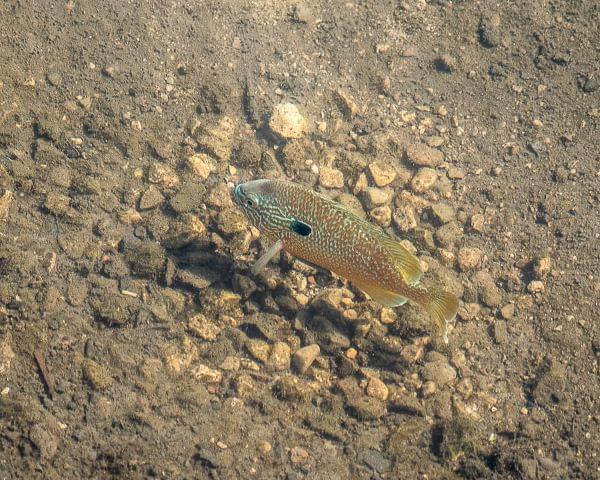Local wildlife and waterways connect us to larger picture

A longear sunfish guarding his nest in the Boneyard Creek. Rob Kanter
My angler’s heart compels me to look over the railings of bridges whenever I get a chance to, and it’s my good fortune to get that chance often as a bicycle between my home in central Champaign and my office at the University of Illinois. The railings I look over are on the White Street Bridge over the Boneyard Creek, at the upstream end of the Second Street Basin. It’s fish I stop to see, and this time of year presents an intriguing fish spectacle, longear sunfish spawning. Did you know some fish make nests?
During the breeding season, which extends through most of the summer, many male sunfish create circular depressions about the size of dinner plates in the gravelly beds of slow moving streams. They then patrol these nests waiting for potential mates to visit, maniacally driving off any other fish that come too close.
When a willing female comes by, the male swims out to greet her and leads her back to the nest, over which they then swim side by side in tight circles. As they circle, she occasionally tips her ventral side up toward him, at which point she releases eggs and he releases sperm. After mating, the female swims off to find another partner and the male fans the nest with his fins. The male longear sunfish who build nests and mate this way are extraordinarily beautiful creatures, whose vibrant colors—bright oranges, blues, and greens—rival those of fish we associate with tropical reefs.
There’s another group of male sunfish who pursue an alternative strategy in the drive to reproduce—scientists who study fish call them “sneakers.” Sneakers are smaller than nest-building males, and they eschew bright coloration in favor of a drabber look. Instead of building nests themselves, sneakers wait nearby for a female to begin spawning with a nest-building male then dash in to add some of their own sperm to the mix.
While my curiosity about sunfish spawning is the thing that prompts me to stop, watching them puts me in a position to appreciate the variety of other life supported by their habitat. At least four other species of fish regularly occupy the little pool where they congregate, including tiny minnows I that can’t name, creek chubs, bluegill, and largemouth bass.
In addition to the fish, a muskrat lives in a burrow in the bank there, accessed by way of an underwater opening. I sometimes see it swim out and clamber up the bank to chew off and gather plants, dragging surprisingly large bunches back to the den in its mouth.
Up under the bridge itself, a pair of barn swallows has been feeding its second clutch of young for the season. Their sturdy nest is constructed of brown grass and dried mud, and it’s attached high on a concrete wall, beyond the reach of predators. The unlovely chicks are now large enough to fill the nest completely, and they compete noisily for the insects the parents catch and bring back throughout the day.
Being still and observing wildlife—especially where there’s a stream involved, and even in a setting where city buses rumble through—reminds me of how thoroughly we humans are connected with each other and the land community. The degree to which the Boneyard Creek supports life in central Champaign is largely determined by the uses and abuses of land upstream. And the degree to which life can thrive in downstream waters, including the Mississippi River and the Gulf of Mexico, is largely determined by the collective health of all the creeks that come together to create them.

